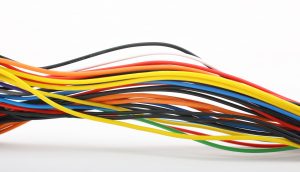
Hazardous substances in plastic components
By Aury Hathout M.Env, certified environmental auditor at www.enviropass.ca
Electronics Environmental Supply Chain cables cables plastic plastic polyvinyl chloride polyvinyl chloride PVC PVCWhile seated comfortably on my favorite couch, talking intensively with my friend using my hands-free headset, the cable dangles closely to my mouth – in a way that I am practically chewing on it. This gets me to consider the fact that most of these every day cables are made of plastic PVC. What exactly is PVC? Are some of its incorporated substances regulated?

The case of PVC
PVC is an abbreviation for polyvinyl chloride. It is used widely in many applications. For example, soft PVC is found in cables, insulating tapes, hoses, balls and toys whereas rigid PVC is used for pipes, gutters and window frames. While PVC is normally rigid, the addition of plasticizers makes it flexible. Why is this chlorinated plastic polymer so popular, especially in the electronics industry? Its success is due to its electrical and fire resistant properties as well as its relatively low cost. However, these benefits must not hide the fact that PVC contains certain hazards. Here are examples of regulated hazardous substances, usages, hazards and regulatory references that are associated with PVC parts:
| Substance name | CAS # | Usage | Hazard | Regulatory Reference |
| BBP – Benzyl butyl phthalate | 85-68-7 | Plasticizer | Endocrine disrupting properties, toxic for reproduction | REACH 1907/2006 Advertisement
RoHS 2015/863 (as of 2019) |
| Boric acid | 10043-35-3, 11113-50-1 | Flame retardant | Toxic for reproduction | REACH 1907/2006 |
| BPA – Bisphenol A | 80-05-7 | Residues from manufacturing processes | Endocrine disrupting properties, toxic for reproduction | REACH 1907/2006 |
| Cadmium and cadmium compounds | 7440-43-9, 10108-64-2, 542-83-6, 7790-79-6, 4464-23-7,
and others |
Heat and UV stabilizer, pigment (yellow and red based colours including green) | Carcinogenic, mutagenic, specific target organ toxicity after repeated exposure | REACH 1907/2006 RoHS 2011/65/EU |
| Chromium and chromium compounds | 1333-82-0, 7778-50-9, 7789-09-5, 10588-01-9, 7789-00-6,
and others |
Pigments (yellow, red and green colours), residues from manufacturing processes | Carcinogenic, mutagenic | REACH 1907/2006
RoHS 2011/65/EU |
| DBP – Dibutyl phthalate | 84-74-2 | Plasticizer | Endocrine disrupting properties, toxic for reproduction | REACH 1907/2006
RoHS 2015/863 (as of 2019) |
| DEHP – Bis (2-ethylhexyl) phthalate | 117-81-7 | Plasticizer | Endocrine disrupting properties, toxic for reproduction | REACH 1907/2006
RoHS 2015/863 (as of 2019) |
| DiBP – Diisobutyl phthalate | 84-69-5 | Plasticizer | Endocrine disrupting properties, toxic for reproduction | REACH 1907/2006
RoHS 2015/863 (as of 2019) |
| DHNUP – 1,2-Benzenedicarboxylic acid, di-C7-11-branched and linear alkyl esters | 68515-42-4 | Plasticizer | Toxic for reproduction | REACH 1907/2006 |
| DIHP – 1,2-Benzenedicarboxylic acid, di-C6-8-branched alkyl esters, C7-rich | 71888-89-6 | Plasticizer | Toxic for reproduction | REACH 1907/2006 |
| Lead and lead compounds | 75-74-1, 7758-97-6, 12656-85-8, 1344-37-2, 78-00-2 and others | Heat and UV stabilizer, pigment (yellow and red based colours including green) | Carcinogenic, toxic for reproduction, persistent bioaccumulative and neurotoxic | REACH 1907/2006
RoHS 2011/65/EU |
| SCCPs – Short Chain Chlorinated Paraffins | 85535-84-8; 108171-26-2 | Flame retardant | Very persistent, very bioaccumulative and toxic | POP 2015/2030 REACH 1907/2006 |
Even if we avoid placing PVC devices in our mouths, we are all directly exposed to these chemicals in our daily activities, whether it be at home, work or on the road. In addition, while the quantities of these substances in PVC may be low, they end up accumulating in the environment and are not easily recyclable. Consequently, places like the European Union, China, Taiwan and California have started to regulate these hazardous substances beginning in the electronic products design stage.
Importantly, the European Union has passed the delegated Directive 2015/863, therefore amending the annex II of Directive 2011/65/EU (also called RoHS recast) while adding 4 phthalates to the restricted substances list: BBP, DBP, DEHP and DIBP. As of July 22nd, 2019, the phthalate restrictions will apply at the homogeneous material level of electrical and electronic equipment. In spite of this, products categories 8 (medical devices) and 9 (monitoring and control instruments) are exempted until July 22nd, 2021.
If you are unsure whether the products you design contain PVC parts and restricted substances, you may consider contacting your suppliers and perform risk assessments. It is not too late to proactively update your products’ environmental compliance system in order to secure your company’s business development.
